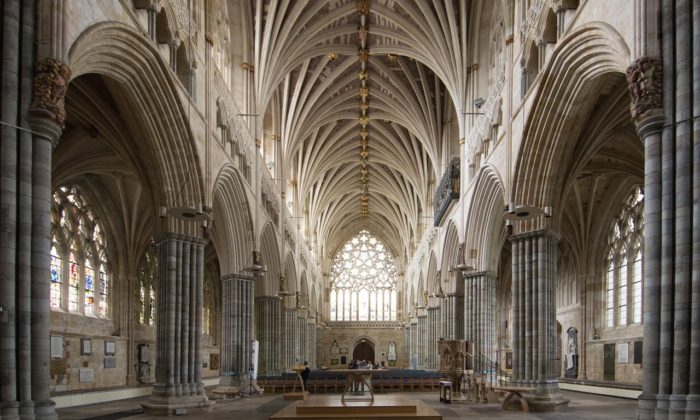Building Legacies
I love architecture. My tastes lean towards the European medieval and Renaissance eras of structural achievement. Put me in a Gothic cathedral or a Baroque palace and I will see you in a couple of days. On a recent trip to Savannah, Georgia, my family was amused at my excitement at the abundance of Victorian- and Colonial-style homes that were thankfully spared General Sherman’s fiery March to the Sea during the twilight of the Civil War. I devour books and documentaries about historical architectural marvels, and while I appreciate modern steel-and-glass structures (I’ve seen the tallest building in the world, the Burj Khalifa, with my own eyes), I feel more in awe of the ornate stone and woodwork in structures built centuries that end with “teen.”
Simply put, architecture is the language of empires, dynasties, and conquerors. Manuscripts can be lost, food and fashion can transcend eras, language changes constantly, but every time a new ruler emerges or a culture shifts, these transitions are clearly delineated in the buildings and monuments that are subsequently produced. It’s a way for kings to leave their mark on their kingdoms during and after their lifetimes. It’s a way for colonial powers to remind the conquered of their masters, even if those masters aren’t present as a significant population. It’s a way to inspire awe and reverence and to instill pride in one’s homeland. Even the smallest village or farm town has a building or structure of note, at least for the locals.

If we look at the Bible, we also see the importance of impressive buildings, particularly in construction of the temple in Jerusalem. The description of Solomon’s temple is glorious, and while we have numerous examples of elaborate structures intended for worship throughout history, none has actually been inhabited by the presence of the Lord itself. The temple in Jerusalem was truly more than just an incredible building, and it represented more than just an imposing space for the Jews to worship. It was consecrated ground with clear boundaries. There was a place for everyone, a place for the priests, and a place for the Holy of Holies.

Image copyright Lucasfilm Ltd.
The rule of thumb for architecture is usually “bigger is better,” and this applies even to fictional structures. The Empire in Star Wars built enormous cruiser ships and of course, the Death Star. The Borg in Star Trek built massive cubes. The Lord of the Rings has a number of structural marvels, such as Barad-dûr, Isengard, the White City, the mines of Moria, Rivendell, and more. Just as real-life kingdoms and empires build things to leave a lasting impression, many realms of science fiction and fantasy devote keen attention to the structures in their stories, which can become characters themselves.
I don’t expect everyone to share my enthusiasm for architecture, but there is far more to a building than just bricks and mortar, especially if it has survived the sands of time. I would encourage you to dig into the history of notable buildings in your area, and I assure you that you will find more than you would expect. And when you come across prominent structures in books or movies, take note of how well (or how poorly) the writers give a sense of historical depth to these buildings, even if it is just in passing.
The old saying goes “If these walls could talk…” As a matter of fact, they do.





































Awww yisss, architecture. Tho Gothic and Baroque are cool and all, I think they’re a bit much. I find pretty woodwork more compelling than stonework. There’s a lot of old craftsman houses where I live now, with noice, thick baseboards and casings and sweet built-in sideboards in the dining rooms.
Do you follow the McMansion Hell blog at all? The author is liberal as heck and puts a lot of it into her criticism of stupid conspicuous consumption, but she’s definitely right about how blah and uggo the bourgeois imitation of stylish wealth is.
What do you think about some of the more modern architecture like this?:
https://i.pinimg.com/564x/61/b0/c7/61b0c77b8396b3103147938465d2b93b.jpg
https://i.pinimg.com/564x/99/21/0d/99210d41c30ced5767e657deeb7cb35a.jpg
https://i.pinimg.com/564x/b6/a2/8a/b6a28abba0e7234a4ff1ba73b4076b8b.jpg
https://i.pinimg.com/564x/86/fb/3c/86fb3cffa64d01ef4cdb9d0e8e81bb3d.jpg
https://i.pinimg.com/564x/6b/f5/d6/6bf5d605970c25ece42af7d356066b86.jpg
https://i.pinimg.com/564x/e5/5e/1c/e55e1cbba96bba73f26fad25d3695a32.jpg
Pretty cool stuff. . . but I have to agree with notleia, beautiful organic woodwork is more emotionally compelling. A lot of the usage of wood in these modern examples is factory-built, made to fake organic woodworking. But… cool designs for sure.
I have mixed opinions about modernist architecture. I can point out parts of things that I’m okay with or not completely sold on, but it’s dependent on the example in question. I don’t care for most of the decor associated with it, tho. Statement walls seem unbalanced to me.
Yeah, it’s kind of a mixed bag for me, too. I like a lot of things about the examples in those pictures, but I don’t like everything associated with that style. So it comes down to the exact design and decor of an individual building. But that tends to be my reaction to just about every style. As for the woodwork that you were talking about…I’d probably have to see examples to say what I think about it. I kind of like older rustic looking wood and stone styles too, though, often enough.
Architecture is awesome. Regretfully, it’s one of the things that’s harder for me to design, draw and color now since I didn’t practice archictural drawing much as a kid. Usually I spent time drawing and coloring the main subject and left the backgrounds blank.
Did anyone else do that as a kid, when it came to the things they drew, or colored in coloring books, or am I the only one that tended to leave the backgrounds blank?
Ah, architecture – I understand the need for depth in detail, yet I often forget to add in those details while I’m writing my first draft. However, the way a character views a place or interacts with it can make a huge difference in the “realism” of a story.
I’ll do this exercise you’ve set – look on the architecture around with fresh eyes, consider how to build it into the worlds I write.
Thanks for the great article!
Timing is everything, isn’t it? This article with its Gothic cathedral illustration appeared so closely after the horrible fire in Notre Dame de Paris. It wasn’t Mark’s intent to write about that but the words about appreciating the buildings around you meshed with my thoughts this week.